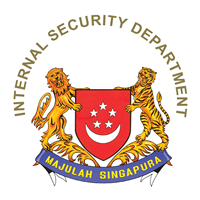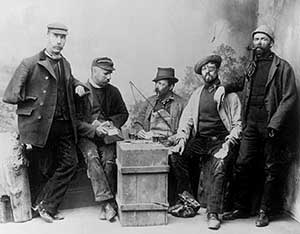Special Branch is a label customarily used to identify units responsible for matters of national security and intelligence in British, Commonwealth, Irish, and other police forces. A Special Branch unit acquires and develops intelligence, usually of a political or sensitive nature, and conducts investigations to protect the State from perceived threats of subversion, particularly terrorism and other extremist political activity.
The Criminal Investigation Department (CID) is the branch of a police force to which most plainclothes detectives belong in the United Kingdom and many Commonwealth nations. A force's CID is distinct from its Special Branch. The name derives from the CID of the Metropolitan Police, formed on 8 April 1878 by C. E. Howard Vincent as a re-formation of its Detective Branch. British colonial police forces all over the world adopted the terminology developed in the UK in the 19th and early 20th centuries, and later the police forces of those countries often retained it after independence. English-language media often use "CID" as a translation to refer to comparable organisations in other countries.

Changi Prison Complex, often known simply as Changi Prison, is a prison complex in the namesake district of Changi in the eastern part of Singapore. It is the oldest and largest prison in the country, covering an area of about 50 ha. Opened in 1936, the prison has a rich history.

The Singapore Police Force (SPF) is the national and principal law enforcement agency responsible for the prevention of crime and law enforcement in the Republic of Singapore. It is the country's lead agency against organised crime; human and weapons trafficking; cyber crime; as well as economic crimes that goes across domestic and international borders, but can be tasked to investigate any crime under the purview of the Ministry of Home Affairs (MHA) and is accountable to the Parliament of Singapore.
Inspector, also police inspector or inspector of police, is a police rank. The rank or position varies in seniority depending on the organization that uses it.

The Internal Security Department (ISD) is the domestic intelligence, counter-espionage, counterterrorism, and primary security agency of Singapore under the purview of the Ministry of Home Affairs (MHA). It is tasked to confront national security threats ranging from subversion or sedition, foreign influence, spying or espionage, domestic or international terrorism, and political or racial/religious extremism.
The Min Yuen was the civilian branch of the Malayan National Liberation Army (MNLA), the armed wing of the Malayan Communist Party (MCP), in resisting the British colonial occupation of Malaya during the Malayan Emergency, The Min Yuen was mainly charged with supplying communist revolutionaries with food, information, and medical supplies.

Bukit Aman is a metonym for a large area that serves as the Royal Malaysia Police headquarters and has several police complexes. It is situated on a hill in Kuala Lumpur known as Bukit Ayang and houses several buildings that serve as the headquarters for some departments of the Royal Malaysia Police. The Malaysia Control Centre, a national level command and control facility, is also located here.

Mamoru Shinozaki was a journalist for Dentsu and spy for the Ministry of Foreign Affairs in pre-war years, a military executive in Japanese-occupied Singapore, and a businessman and writer in post-war years. He is known for the Shinozaki Case in 1940, and for his testimony in the war crimes trial in 1947 for the Sook Ching massacre.

The Royal Malaysia Police, is a (primarily) uniformed national and federal police force in Malaysia. The force is a centralised organisation, and its headquarters are located at Bukit Aman, Kuala Lumpur. The police force is led by an Inspector-General of Police (IGP) who, as of 23 June 2023, is Razarudin Husain.

The Kempeitai East District Branch was the headquarters of the Kempeitai, the Japanese military police, during the Japanese occupation of Singapore from 1942 to 1945. It was located at the old YMCA building, at the present site of Singapore's YMCA Building on Stamford Road. Opened in 1911, the distinctive Art Deco YMCA building was the site of interrogation and torture of many innocent civilians, including the war heroine Elizabeth Choy. After the war, the Singapore government erected several memorials with some at the former massacre sites. In 1995, the former site of the old YMCA building was gazetted by the National Heritage Board as one of the eleven World War II sites of Singapore.
The Criminal Investigation Department (CID) in the Irish Free State was an armed, plain-clothed counter-insurgency police unit that operated during the Irish Civil War. It was organised separately from the unarmed Civic Guard police force. The unit was formed shortly after the truce with the British and disbanded in October 1923.

The Criminal Investigation Department is a specialized intelligence and investigation wing of the Bangladesh Police. It is headquartered in Malibagh, Dhaka and maintains a training school named the Detective Training School. Personnel attached to this wing essentially work in plain clothes. Mohammad Ali Mia, BPM, PPM is the head of the Criminal Investigation Department.
A Crime Investigation Department (CID) or Crime Branch is a branch of the state police departments of India responsible for the investigation of crime, based on the Criminal Investigation Departments of British police forces. It's the specialised investigation wing of the state police, and headed by an officer of the rank of Director General of Police or Additional Director General of Police (ADGP).
Leonard Francis Comber was a British military and police officer, and later book publisher, operating in British India, Malaya, Singapore, Hong Kong and Australia. He was also an editor and author of books relating to South-East Asia.
The Criminal Investigation Department (CID) is one of the many departments under the Singapore Police Force for premier investigation and staff authority for criminal investigation matters within the Singapore Police Force.
The Special Forces and Elite Forces include both a specially and higher trained unit and a small percentage of personnel from a specific Malaysian military branch, law enforcement or government agency. In Malaysia, the term 'Special Forces' is widely used by uniformed services for special forces, special operations forces and 'special' trained units while 'Elite Forces' for units that more trained and capable combat. Regular personnel must undertake specialized and higher training to be able to join the units of the 'Special and Elite Forces'. These "Special Elite Forces" are denoted by different beret colours, shoulder tabs, unit patches, skill badges and uniforms.
The Malayan Security Service (MSS) was the domestic intelligence service of colonial Malaya and Singapore from 1939 to 1948. It was established to replace and centralize the operations of the individual intelligence agencies of the Federated Malay States and Straits Settlements under one, Pan-Malayan organization for the entire Peninsular. It was modeled closely after the MI5, the United Kingdom’s domestic counter-intelligence service, in that it was primarily tasked with information gathering and had no executive powers to detain or arrest. It was distinct and separate from the Criminal Investigational Division Branches (CID) of the Malayan or Singapore Police.

Special Branch was a unit in the Metropolitan Police in London, formed as a counter-terrorism unit in 1883 and merged with another unit to form Counter Terrorism Command (SO15) in 2006. It maintained contact with the Security Service (MI5) and had responsibility for, among other things, personal protection of (non-royal) VIPs and performing the role of examining officer at designated ports and airports, as prescribed by the Terrorism Act 2000.

John Le Cain was a Thai-born Singaporean former police officer that served as the Commissioner of Police in Singapore from 1964 to 1967. As a Eurasian, he was the first Asian to be appointed to that post.










